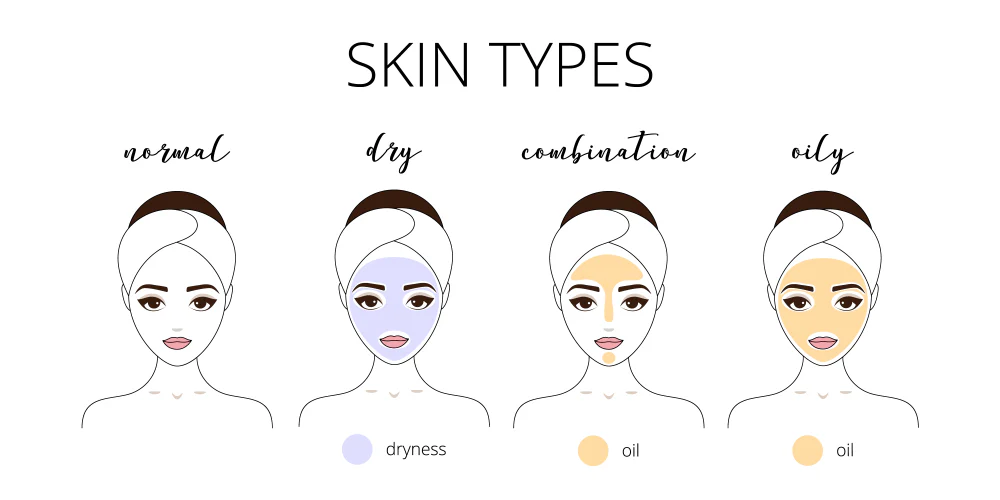
Do you know what’s the reason behind an appropriate skincare routine? Knowing your skin type is!
From breakouts to dryness to a shiny T-zone, knowing your skin always helps you choose appropriate products and treatments for your skin.
If you want to know whether your skin is oily, dry or combination type—this is a simple guide for you.
Table of Contents
But, Why Is Knowing The Skin Type Important?
Using skin care products targeted at a skin type other than your own can often do more harm than good. Applying a rich moisturiser to oily skin will block the pores and promote outbreaks of various kinds, whereas using a cleanser for oily skin to dry skin could strip it of all the moisture it needs, leaving it flaky and irritated.
Knowing your skin type will also help you tackle any specific skin concerns, such as ageing, acne, and dark circles and you may get the most of the benefits of skincare products.
Let’s See How You Can Understand Your Skin Type.
Oily, dry, combination, and sensitive—These are four main skin types. Here’s how to find out yours.
The Bare Face Test
It’s the most simple test to understand your skin type.What you have to do is, simply wash your face with a mild cleanser, pat dry it, and leave it for an hour. There is no need to apply a moisturiser or any other skincare products.
- Oily Skin: If your face looks shiny, especially your forehead, nose, and chin-all the areas called the T-zone-you have oily skin.
- Dry Skin: When your skin is felt to be tight or your skin is flaking, particularly on your cheeks, it is a sign of dry skin.
- Combination Skin: When you feel the oily T-zone but your cheeks feel dry, it’s probably a combination skin.
- Sensitive Skin: Itchy, red, or irritated-this is what defines sensitive skin.
Bonus Tip: Check out this guide if you are looking for How to get rid of black circles.
The Blotting Sheet Test
A blotting sheet test will give you a clear idea about how much oil your skin produces. Take a blotting sheet and lightly press it onto different areas of your face, particularly the forehead, nose, and chin.
- Oily Skin: It will pick up lots of oil, thus indicating oily skin.
- Dry Skin: If not much, or no oil at all, comes off onto the sheet, then your skin is probably dry.
- Combination Skin: The sheet will take oil off from your T-zone but remain clean everywhere else.
- Sensitive Skin: This method may not indicate sensitivity, but if your skin responds to the blotting sheet by becoming red or irritated, it may be sensitive.
Characteristics of Each Skin Type
Here is a more detailed insight into the characteristics of each skin type for easier identification and knowledge into which category you fit.
- Oily Type
Oily skin is usually characterised by excessive sebum production, making your face look greasy. It may be acne-prone or have blackheads due to clogged pores. Individuals with oily skin should use only oil-free, non-comedogenic products to prevent their skin from producing excess oils.
- Dry Type
When you touch it, the dry skin feels rough and sometimes flaky in cold weather. It lacks the percentage of moisture to maintain a good barrier. Hydrating products, such as hyaluronic acid lotions or serums, soothe dry skin and help restore it.
- Combination Type
Combination skin is when your skin tends to incorporate both oily and dry areas. This is commonly observed in the T-zone area, as it tends to be oily, while the cheeks tend to remain dry. Addressing it with lightweight products for oily areas and richer moisturisers on dry zones will maintain this skin type in balance.
- Sensitive Type
Sensitive skin reacts readily to cosmetics or the elements. It itches, burns, or turns red after coming in contact with certain products. If you have sensitive skin, try to look for fragrance-free and hypoallergenic products meant for it.
Personalise Your Routine
Once you have identified your skin type, you may tailor skincare more to your specific needs. If you are concerned with fine lines around the eyes, you may add some LED eye patches online to your routine that will help combat those wrinkles quite effectively.
Always check the ingredients in the products you use. If you have oily or acne-prone skin, it is better to avoid heavy oils. If you have sensitive skin, try to avoid harsh chemicals in general.
Determining your skin type doesn’t have to be complex. A few simple tests will give you all the information needed to outline a skincare routine that works for you. Once you have identified your skin type, whether oily, dry, combination, or sensitive, you can begin selecting appropriate products to keep your skin looking and feeling its best.